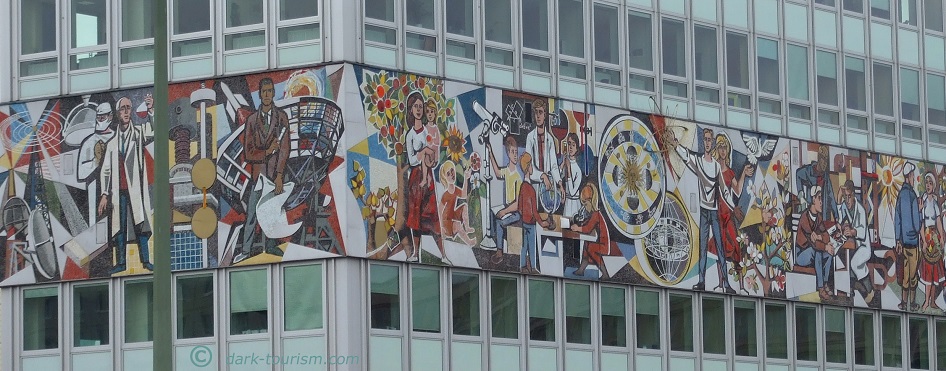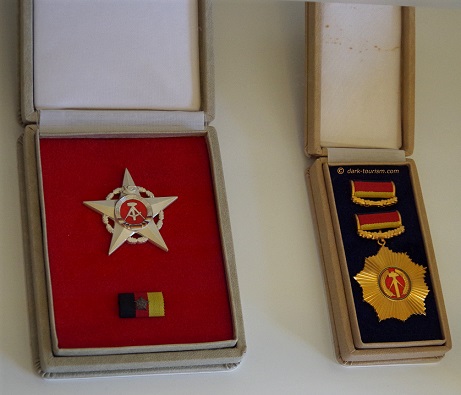On this day, 7 October, the former GDR (in the West aka ‘East Germany’) used to celebrate the anniversaries of its founding on that date in 1949. It managed to get to its 40th anniversary in 1989 – but that was at a time when severe cracks in the state’s regime were already more than apparent. A few weeks later the Berlin Wall fell and just days before it would have been the 41st anniversary of the GDR’s founding, the state had ceased to exist on 3 October 1990 (see this recent post).
I used to mark this day, “Tag der Republik” in GDR parlance (literally ‘day of the republic’), on my former DT page on Facebook before it got purged, so I’m using this opportunity to dig into my archive again.
This was the post on Wednesday 7 October in 2015:

“Photo of the Day: 7 October, “Tag der Republik”, was for 40 years the GDR’s anniversary of its founding in 1949 – up to the very last celebration in 1989 when the GDR was already heading towards collapse. While GDR leader Erich Honecker was still rambling on about the GDR’s and socialism’s longevity, the USSR‘s Mikhail Gorbachev (as guest of honour) made ominous remarks about the GDR regime’s inability to reform. Demonstrators in the streets shouted “Gorbi, Gorbi”, not “Erich, Erich”, so it was made publicly clear who the people were putting their hopes in (NOT the old guard!).
Only a month later, Honecker was deposed and the Berlin Wall had fallen. Before it could come to a 41st “Tag der Republik”, that republic had been dissolved on 3 October 1990 with Germany’s reunification (see the posts on 3 and 4 October).
Of course that didn’t stop some of the old guard from continuing to celebrate this day in private, including Erich’s widow Margot Honecker, who lives, unrepentant, in exile in Chile. 20 years on video footage of her and some guests celebrating the 60th “Tag der Republik” emerged … some just cannot accept the course of history … [UPDATE: she has meanwhile passed away, in May 2016, still unrepentant to the last moment.]
This photo shows the state emblem of the GDR, now a museum piece, on the outside wall of the Checkpoint Charlie Museum in Berlin … (ironically the sign is towering above the four WWII Allied flags).”
And this was the post on Friday, 7 October 2016:

“On this Day: it’s “Tag der Republik” (‘Day of the Republic’), more specifically: the 67th anniversary of the founding of the GDR (‘German Democratic Republic’, aka East Germany) … or rather: it would have been, if the GDR still existed and hadn’t been dissolved just a few days short of its 41st anniversary back in 1990 (see the post from the beginning of this week).
This photo shows the former state’s official symbol, which also featured in the centre of its national flag. Since it’s been confined to history this symbol is, for the most part, only ever seen in historical museums these days. This particular specimen was photographed in the relatively new “Life in the GDR” museum in the Kulturbrauerei, Berlin.”
The next two years I did not mark this date, but resumed it on Monday 7 October 2019:

“… so another GDR-related post … Because: on this Day, it used to be “Tag der Republik” (‘republic day’) in the GDR, marking the founding date of the socialist state, 70 years ago, on 7 October 1949. But it just about made it to its 40th anniversary, a month later the Berlin Wall came down (well, not literally yet, but the border crossing points opened), and less than a year after the GDR ceased to exist.
I already mentioned the notion of “Ostalgie” (‘nostalgia for the East’) that developed in the wake of the GDR’s demise. To counter it I chose to post a picture of something that won’t be fondly remembered by most, as it was a decidedly dark side of the GDR regime … This is an interrogation room of the Stasi, the “Staatssicherheit”, the GDR’s secret security police system. You certainly wouldn’t have wanted to find yourself sitting on that chair opposite the desk with the tape recorder (for the younger readers: that’s that device on the right, used to make recordings of the interrogation … these were pre-digital days, remember …).
This particular interrogation room has been preserved as part of the Lindenstraße Prison memorial site in Potsdam, Brandenburg, just outside Berlin.
I re-watched the movie “Das Leben der anderen” (‘The Life of Others’) again yesterday … it brought the whole Stasi topic back to mind. It’s simultaneously repulsive and nonetheless fascinating, how such a comprehensive surveillance system could be kept going so long and so efficiently.”
But I had also posted GDR-related things on other dates, so I trawled through my archive to find a few of those to include here as well; here we go:
Tuesday 3 March 2016:

“Photo of the Day: time for something a little more “uplifting” .. or at least that’s what this was supposed to be. It’s the famous socialist-realist frieze on the “House of Teachers” in East Berlin near Alexanderplatz. It’s one of the most stunning relics of the former GDR and the Eastern Bloc.
But beyond the often gigantic dimensions (this is 7m high and over 100m long in total), it is precisely that ludicrous level of pretence that I like about socialist-realist art. You cannot take it seriously for its “message” (I wonder if anybody involved ever has done, including the artists themselves).
Once you see beyond these exerted attempts at making socialism appear like the people’s paradise on earth, then you can really actually like this sort of art. I do. I find it both historically interesting and often highly amusing at the same time. And this is one glorious example of the style!”
And this is adapted from a post from Wednesday 5 October 2016:

“This room oozes that stifling GDR atmosphere, partly down simply to that late 1970s interior design – that wallpaper in particular! – not just the obligatory portrait of then GDR leader Erich Honecker on the wall opposite (like Big Brother is watching you).
Of course, crossing the border as a Westerner would not normally have involved a visit to this room. If you were ‘invited’ to sit down opposite the man with the typewriter, it meant you were in trouble and in for a proper interrogation by a Stasi officer. Fortunately, I never had that experience, but the general intimidation by the regular border guard checks was uncomfortable enough.
Such was the paranoia of the GDR regime about ‘people trafficking’ (i.e. GDR citizens trying to flee to the West) that apparently they even had a secret giant X-ray machine at Marienborn through which all vehicles passed. That is: people were, without their knowledge, subjected to doses of gamma ray radiation. Spooky, spooky stuff …”
On Wednesday 12 September 2018 I posted the following:

“On this Day, 28 years ago, on 12 September 1990, the so-called ‘Two Plus Four Treaty’ (in German: “Zwei-Plus-Vier-Vertrag”) was signed. Its official full title was ‘Treaty on the Final Settlement with Respect to Germany’ (in German: “Vertrag über die abschließende Regelung in Bezug auf Deutschland”). The two were the GDR and the FRG (East and West Germany) and the four the victorious powers of WWII: Britain, France, the USA and the USSR.
Through this treaty the former Eastern German state (the GDR) ceased to exist and Germany was reunified and finally granted full sovereignty by the former Four Powers that until then had reserved several rights within Germany (and maintained a sizeable military presence). Until then Germany had technically still been at war with the Allies, since WWII was ended only with a ceasefire but not a proper peace treaty. That was because the Cold War got in the way, so such a treaty had not been in the interests of either the Eastern Bloc and the USSR or the Western Allies.
This is why the reunification of Germany is seen by many as the most significant event that ended the long era of the Cold War.
But that didn’t mean the dark days were completely over – for some, the so-called losers of reunification (“Verlierer der Wiedervereinigung”), i.e. especially in the East, a new kind of struggle was only beginning … And we can still see the rift between East and West in Germany to this day …
Today’s photo shows a reconstructed typical GDR-era living room that is on display at the DDR-Museum (GDR museum) in Berlin. It’s a place full of “Ostalgie” (a blended word incorporating “ost”, ‘east’, and “Nostalgie”, ‘nostalgia’), i.e. fond memories of the “good old days” of life in the GDR. Yet the museum does not shy away from also covering the very dark sides of that era, e.g. with a reconstructed Stasi listening post reminiscent of the movie “Das Leben der Anderen” (‘The Life of Others’).”
The very final GDR-related thing I was able to post was shortly before the sudden purge, namely on Wednesday 8 April – at a time when I made frequent references to the corona virus pandemic – was this:

“Photo of the Day: oh those communists! No social distancing at all … and they even still shake hands!!!
But seriously, this is a socialist-realist mural found in Berlin Mitte, formerly part of the capital of the GDR, i.e. East Berlin, celebrating the workers-and-peasants’ paradise that this state was supposed to be.
You have to wonder, though, how a state like the GDR would have handled a scare like our current corona crisis … probably a bit like the Chinese, I should guess. But a proper contemporary comparison would be with North Korea, except that that country is currently closed off and not much info is getting out. However, there had never been that much internal travel there anyway, so they probably have it a bit easier as far as containing the spread is concerned. But how many ICUs with ventilators do they have?
Another North-Korea-like totalitarian state (though not communist, but full-on cult-of-personality autocratic) is Turkmenistan. And I just read that there the media aren’t even allowed to make any references to COVID-19. If that is true, it will be interesting to see how that experiment will pan out …”
Moreover there are yet more GDR-related photos already brought back on this blog, such as the three GDR-insignia ones already posted on Saturday:



And finally I could also re-use this one from the “fluffy side of X” series re-posted here on 28 May:




